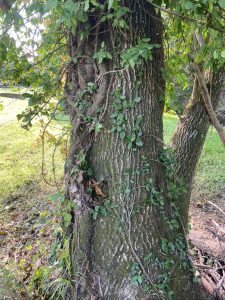For my species, I decided to finally take a closer look into the ivy I have been watching over the last few weeks. It was a warmer day, around 70 degrees and sunny. The weather was absolutely perfect to sit outside, especially with all the cooler days we’ve been having. Southwest Virginia in the early fall is my absolute favorite and this was a perfect example of it.
When I checked on my ivy, I didn’t notice much growth or change. It’s consistency has been very comforting in a world where so much is changing all the time. As I started my observation, I begin to regret picking a plant. I realized there wouldn’t be any dynamic changes during my 30 minutes and I felt like I would be staring at a tree for half an hour. However, it ended up being much more therapeutic and interesting than I anticipated.
While there weren’t any changes in the ivy, there were plenty of ants and spiders that made their way around the tree trunk. They seemed to be drawn to the deep green leaves and walked close to the edges of the vine. There’s been a lot going on in my life over the last few weeks and just watching the leaves do their one job in life was such a moment of clarity. Those leaves just have to focus on making chlorophyll, growing up the tree, and just surviving day to day. It’s a great reminder of how simple life can truly be if we don’t get blinded by everything else going on.
After observing for some time, I decided it was time to start working on my species identification. The leaves are rounded and feel almost plastic-y. They are a solid deep green with a lighter green/brown vine. I went on an internet search to try to find what type of vine this could be. After a deep search, the best match I could find was the Japanese honeysuckle (Lonicera japonica).

Japanese honeysuckle is a non-native invasive weed that is now common in the Appalachian region. This weed has non-lobed, egg shaped leaves. The vine can grow up to 30 feet in height and climbs any support structures nearby. In the late spring to early summer, the Japanese honeysuckle plant has yellow and white flowers. It is considered to be semi-evergreen because the leaves remain through most of the year.
Japanese honeysuckle was initially introduced to the United States in Long Island, New York in 1806 for ornamental and wildlife uses. Since then, it has become one of the most recognizable ornamental vines along the entire Eastern US stretching into Wisconsin and Texas. Since moving into so many environments, the Japanese honeysuckle has adapted to be able to grow in a wide variety of habitats and sun coverage.
This plant is extremely fast growing, thus posing an ecological threat to native species. It grows and twists around support structures and can eventually over take them and kill them. In full sun conditions, the plant can smother and kill other vegetation growing below it.
Resources:
Koepke-Hill, R.M., Armel, G.R., Richardson, R.J., Rhodes, Jr., G.N.. Invasive Weeds of the Appalachian Region. The University of Tennessee: Institute of Agriculture. UT Extension. PB1785 (35).
Sinclair, S.B. (December 2, 2015). Buttermilk Trail Section 2. VCU Field Botany.rampages.us/…2/buttermilk-trail-section-2 .
Japanese Honeysuckle. (November 11, 2010).nps.gov/…/alien/pubs/midatlantic/loja.htm .

Oh my goodness! I wouldn’t have even considered taking the insects surrounding the ivy as a change! That’s a very clever and I like that you included that!
Also, this seems like a small thing, but I love the symbolism and similes that you make when talking about the ivy being consistent and the leaves making it through day to day! It makes this a very thoughtful read, where otherwise it might just be simply informative. Thanks!